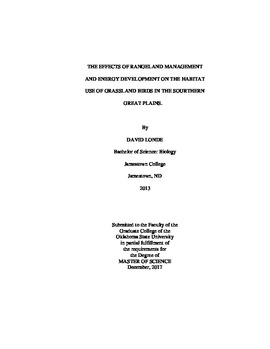| dc.contributor.advisor | Fuhlendorf, Samual D. | |
| dc.contributor.author | Londe, David William | |
| dc.date.accessioned | 2018-06-25T16:31:22Z | |
| dc.date.available | 2018-06-25T16:31:22Z | |
| dc.date.issued | 2017-12-01 | |
| dc.identifier.uri | https://hdl.handle.net/11244/300305 | |
| dc.description.abstract | Grasslands were historically disturbance dependent systems with the function and structure of grasslands being shaped by variable disturbance from fire and grazing. Many grasslands are currently managed under heavily altered disturbance regimes, which has led to a concomitant decline of diversity and abundance of many grassland wildlife species. Efforts to prevent further losses of biodiversity in grasslands has emphasized the restoration of heterogeneity through the reestablishment of the fire grazing interaction. However, the reintroduction of heterogeneity has taken place in the context of the continued fragmentation of grasslands for energy development. Fragmentation of grasslands has the potential to limit the effectiveness of heterogeneity-based management as many wildlife species avoid or are displaced from otherwise suitable grasslands as a result of energy development. We examined the habitat and space use of grassland birds in the Southern Great Plains in a landscape that is managed for heterogeneity with fire and grazing, but has also experienced substantial development for oil and gas production. Grassland songbirds showed a highly variable tolerance for energy development. Henslow’s sparrows (Ammadromous henslowii) was the most sensitive species, avoiding oil wells in all unburned patches. Most other species response was highly dependent on the type of infrastructure and time since fire patch, suggesting heterogeneity may moderate many species responses to energy development. Female greater prairie-chickens (Typmanuchus cupido) habitat use was primarily driven by use of the vegetation mosaic that results from fire and grazing, with individuals using unburned patches during the nesting and lekking seasons then shifting use to recently burned patches in the post-nesting and nonbreeding season. Greater prairie-chicken response to energy development was more complex with individuals showing a seasonally dependent avoidance of high densities of oil wells and power lines. Our results suggest that the use of heterogeneity based management will continue to be an important conservation strategy for grassland birds, however efforts should be made to limit further fragmentation of grasslands as the presence of infrastructure has the potential to significantly degrade significant portions of the landscape for some grassland bird species. | |
| dc.format | application/pdf | |
| dc.language | en_US | |
| dc.rights | Copyright is held by the author who has granted the Oklahoma State University Library the non-exclusive right to share this material in its institutional repository. Contact Digital Library Services at lib-dls@okstate.edu or 405-744-9161 for the permission policy on the use, reproduction or distribution of this material. | |
| dc.title | Effects of Rangeland Management and Energy Development on the Habitat Use of Grassland Birds in the Sourthern Great Plains. | |
| dc.contributor.committeeMember | Elmore, R. Dwayne | |
| dc.contributor.committeeMember | Davis, Craig A. | |
| osu.filename | Londe_okstate_0664M_15480.pdf | |
| osu.accesstype | Open Access | |
| dc.description.department | Natural Resources and Ecology Management | |
| dc.type.genre | Thesis | |
| dc.type.material | text | |
